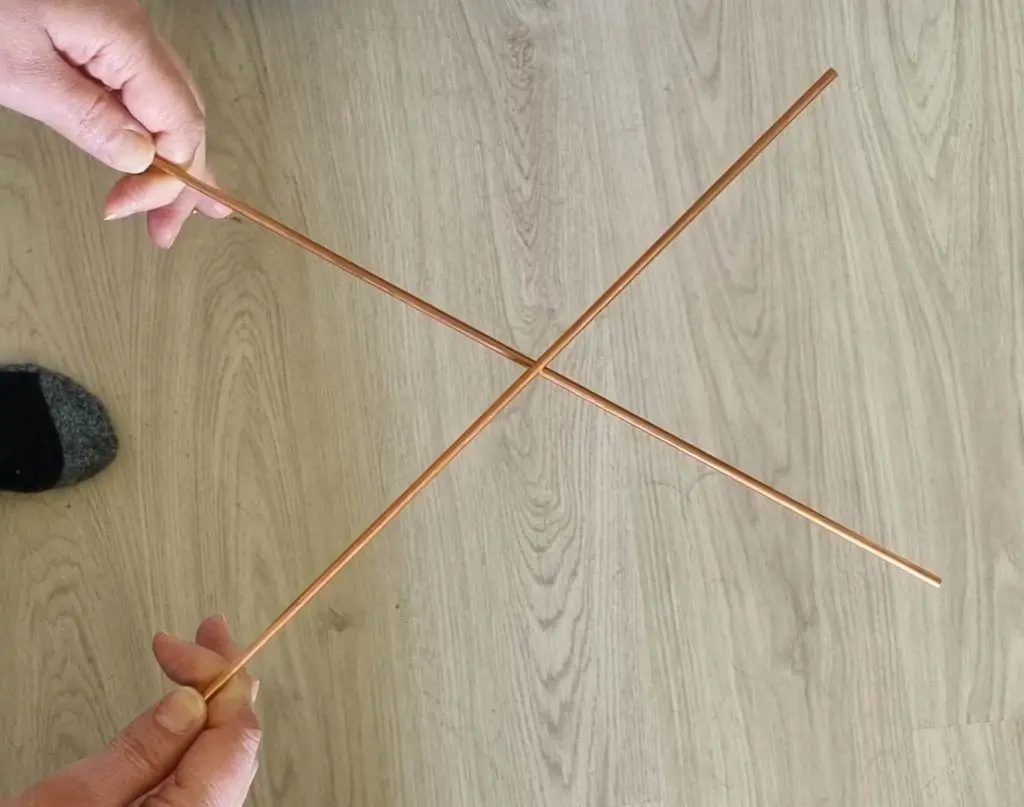In the realm of paranormal investigations, tools play a crucial role in unraveling the enigmas that surround us. The dowsing rod is one such tool steeped in history and intrigue.
Often associated with locating water sources, dowsing rods have also found their place in paranormal investigations.
This blog post will explore the scientific principles behind dowsing rods and provide a step-by-step guide to effectively using them in your paranormal investigations.
We will focus on finding energetic anomalies in this article. You can also use dowsing rods for spirit communications.
Understanding the Science Behind Dowsing Rods
Before delving into the practical usage of dowsing rods, it is essential to understand the scientific principles at play.
Dowsing rods typically consist of two L-shaped rods, usually made of metal or wood, held by the investigator.

According to proponents of dowsing, the rods are believed to respond to subtle energy fields or forces emitted by paranormal entities or objects.
If you want to take a closer look at the dowsing rods I use, you can find them on my recommended products page.
Step-by-Step Guide to Using Dowsing Rods
This step-by-step guide teaches you everything you need to know to use dowsing rods in your paranormal investigation. Be sure to have fun and keep an open heart at all times. When you get to tens, they tend to “jam.”
Step 1: Choose the Right Dowsing Rods
Selecting the appropriate dowsing rods is essential for accurate results. Ensure that the rods are made of conductive material such as metal or brass, as they are more responsive to energy fields.
Step 2: Hold the rods correctly
Hold the rods lightly by their handles, allowing the longer ends to move freely. Keep your arms close to your sides, and ensure space between the rods. I point my arms straight forward, trying not to bend the arms “inwards” or “outwards.” Try to relax your shoulders and breathe relaxed and slowly.

Look at the dowsing rods I use and love over on the recommended products page.
Step 3: Establish a Baseline
Before embarking on your investigation, establish a baseline reading by holding the rods in a neutral position. Walk the site and note any “hits” or “anomalies” in a notebook. I tend to use a grid system. You find more information on how to create a grid system here.
An anomaly is detected when the rods cross, spread apart, spinn, or point in a specific direction. If the rods point in a particular direction, follow it. In many cases, you will find an anomaly.
- Rods cross
- Rods diverging
- Spinn
- Point in a specific direction (follow the direction)
Below you will find photos of the positions of the rods. Note that I am holding the rods to stabilize the movement. It would be best if you did not restrain the rods when doing a reading.



If you want to locate a spirit portal using your dowsing rods, I also have an article about this. You will find the article below.
Related article: How to Locate a Spirit Portal using Dowsing Rods
Step 4: Focus Your Intention
Clear your mind and focus your intention on the purpose of your investigation. It is essential to maintain a calm and focused state of mind. Dowsing rods are known to jam if you feel tense or stressed out.
Step 5: Begin the Investigation
Hold the rods lightly, allowing them to move freely. If they start to spin and make a fuss, try to tilt them slightly. This takes the sensitivity off, so don’t tilt them too much. It is a balancing act; with time and experience, you learn your sweet spot.
Start walking slowly and deliberately through the area of interest, paying close attention to any changes in the orientation or movement of the rods.
As you encounter potential paranormal phenomena, the rods may start crossing, pointing towards a specific direction, or diverging.
Step 6: Validate Findings
Critical thinking and validation are vital in any scientific endeavor. Once you receive a response or observe a change in rod movement, cross-reference it with other investigative methods or devices, such as an EMF (Electromagnetic Field) meter, to corroborate your findings.
I always tend to use different methods to verify my findings. If you only use one method, the evidence is more readily challenged. Psychic evidence is very weak in the eyes of science, so if you are trying to find scientific proof, it is better to use tools that can measure known metrics.
Step 7: Conclude and Document
After conducting your investigation, take time to evaluate and analyze your findings. Document your observations and any relevant information that might provide additional context to your investigation.
It is always better to be more detailed than you think you need to. Note everything you find, and take time to describe it in detail. As knowledge about the paranormal deepens, we might overlook parameters that will be important later on.
Make sure that you note at least the following parameters in your investigation report.
- Weather conditions
- Barometric pressure
- Existence of ley lines
- Previous information about the haunting (if any)
- Tools used and how the investigation was conducted
- Store recordings and evidence neatly
- Psychic input
- How many were present at the investigation
- Contact details for the persons involved in the investigations (team and witnesses)
- Permissions
- Findings and conclusions
If you want to learn more about how to conduct a paranormal investigation, you will find lots of helpful information in the article below.
Further reading: How to hunt ghosts: A beginner’s guide
Final thoughts
Using dowsing rods in paranormal investigations can be an intriguing and valuable tool.
Understanding the scientific principles behind dowsing rods and following a systematic approach can enhance your chances of uncovering paranormal phenomena.
However, exercising critical thinking and validating your findings through multiple sources and methods is essential.


